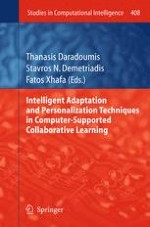Adaptation and personalization have been extensively studied in CSCL research community aiming to design intelligent systems that adaptively support eLearning processes and collaboration. Yet, with the fast development in Internet technologies, especially with the emergence of new data technologies and the mobile technologies, new opportunities and perspectives are opened for advanced adaptive and personalized systems. Adaptation and personalization are posing new research and development challenges to nowadays CSCL systems. In particular, adaptation should be focused in a multi-dimensional way (cognitive, technological, context-aware and personal). Moreover, it should address the particularities of both individual learners and group collaboration. As a consequence, the aim of this book is twofold. On the one hand, it discusses the latest advances and findings in the area of intelligent adaptive and personalized learning systems. On the other hand it analyzes the new implementation perspectives for intelligent adaptive learning and collaborative systems that are brought by the advances in scripting languages, IMS LD, educational modeling languages and learning activity management systems. Given the variety of learning needs as well as the existence of different technological solutions, the book exemplifies the methodologies and best practices through several case studies and adaptive real-world collaborative learning scenarios, which show the advancement in the field of analysis, design and implementation of intelligent adaptive and personalized systems.
